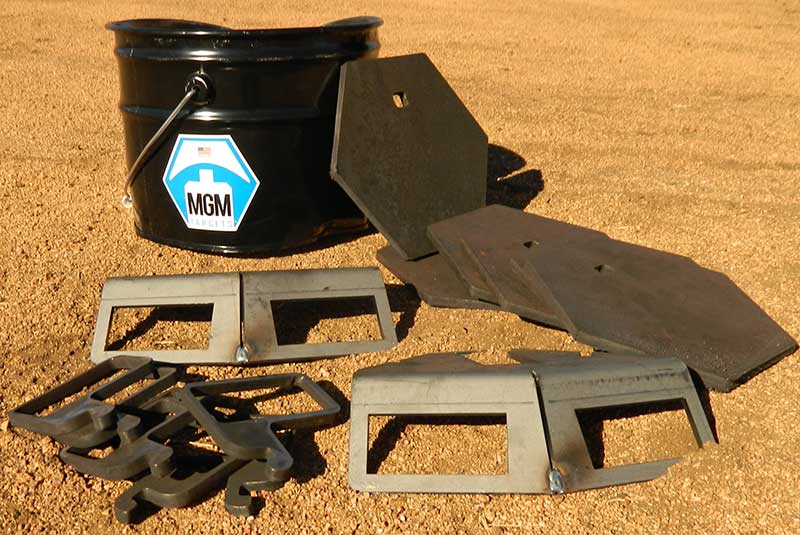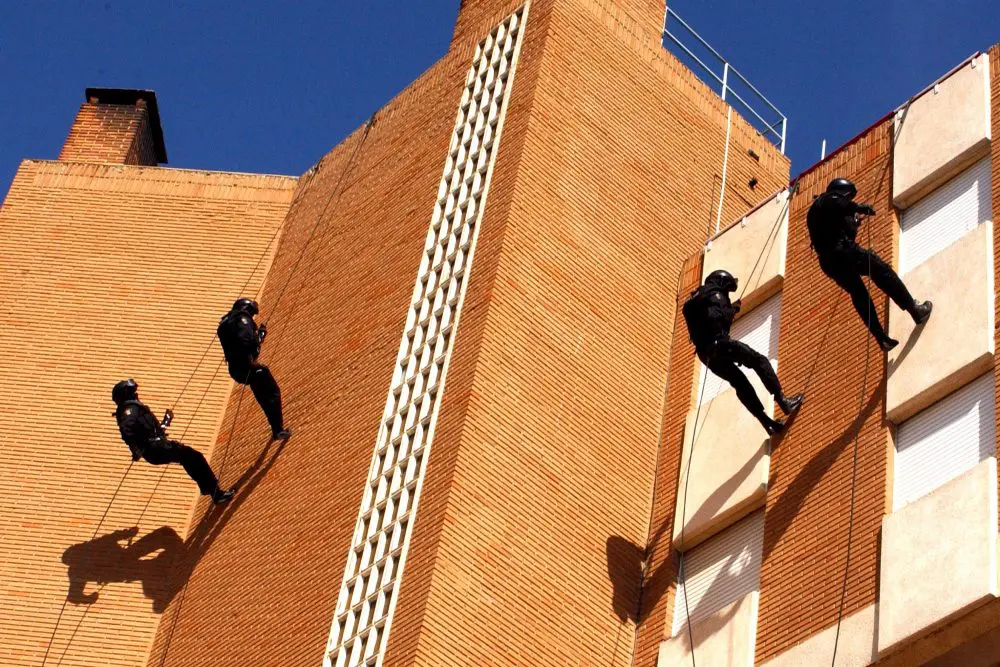I hear this a lot as I teach around the country, whether for the NRA, my own classes, or state POST courses. There is no question that there’s a tremendous need for closequarters carbine and high-risk entry training, but does the deputy in Snake’s Belly, Wyoming really need it?
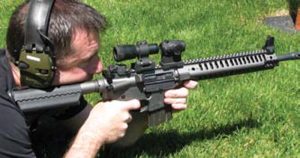
The officer in a small rural department might be better served with training focused on what most cops really do: stand behind a tree, telephone pole or braced over the hood of a car—for hours—before taking a body shot at a reasonable distance.
There’s always been an argument that scopes don’t help you shoot better, they just let you see better. I’ll leave that argument to smarter guys than me. I know that I can usually get better hits when I shoot things using a scope, and good hits are what count.
My go-to AR is a Next Generation Arms set up with a Leupold 1.5-5X variable and Aimpoint Micro T-1, both in LaRue QD mounts. The T-1 is offset at 45 degrees. I leave the scope on it. If I need a red dot, I can rotate the rifle slightly inward, maintain a cheek weld, and shoot up close.
If an optic on an M16 didn’t work, the Marines wouldn’t be using Designated Marksmen (DM) in Afghanistan so effectively today.
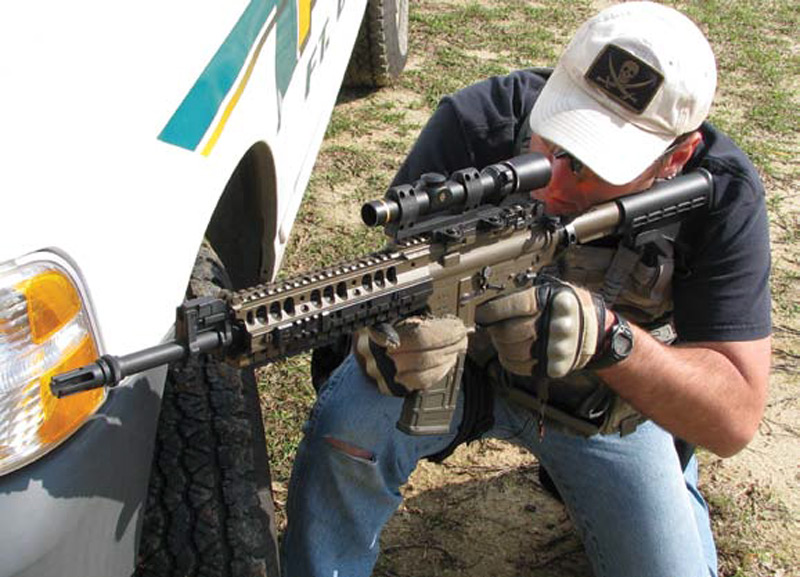
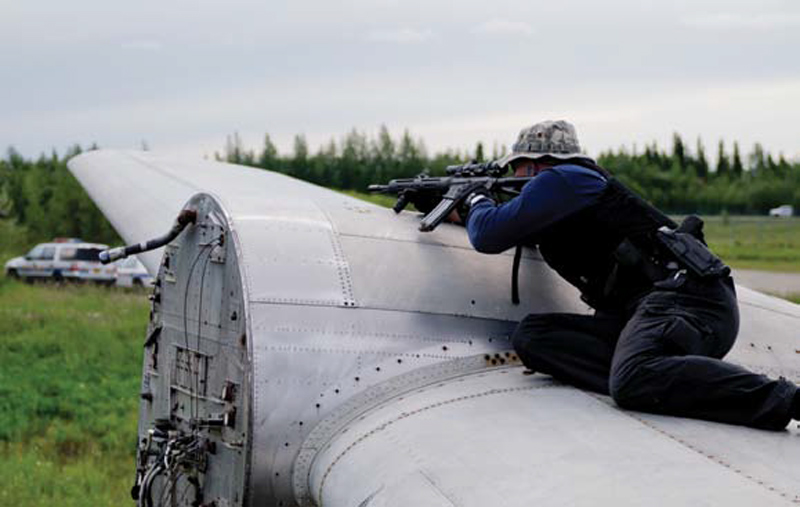
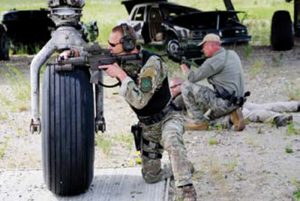
Table of Contents
SHARPSHOOTERS
The DM concept is nothing new. “Sharpshooters” were used as far back as the American Revolution, with better shots assigned to target officers. My father jumped on D-Day with the 101st Airborne. One private carried an ‘03 Springfield with Weaver 4X scope, and was used to shoot at ranges a little far for the M1 Garand with iron sights. He wasn’t considered a sniper, just a good shot who could reach out and touch someone.
As soon as you say “scope,” too many guys start talking come ups, match ammo, windage, clicks—none of which apply to the DM. The DM takes his rifle or carbine, sighted for 50 yards, and shoots it as-is. Most coppers don’t have the time, equipment or skill to accurately estimate range and make adjustments, so they need to know they can hit with the gun as it comes out of the trunk.
But they do need to know the trajectory of the duty round. In rare cases, the shooter may have to hold over or under, depending on the shot and range. For example: a 50-yard zero will make the shot (55-grain .223) about 1.5 inches high at 100 yards. If you need to hit him in the eye at 100 yards, you need to hold a little low.
For a body shot, it shouldn’t be an issue from 25 to 250 yards. The average human male is 17 inches from throat to belt; with a 50-yard zero, the 55-grain bullet will be approximately 1.2 inches low at 25 yards, 1.5 inches high at 100, and 1.5 to 2 inches low at 250 yards.
This allows for a point-blank shot (center chest) from 25 to 250 yards with no hold-over (or under). For most real police shootings, this should do the trick. Each officer should determine his perceived need and zero the rifle at the distance he thinks he’ll need to shoot it, then figure the trajectory for the round/ rifle he’s using. Ballistic tables are suggestions, and lots of factors can change the flight of the bullet. But for most officers, a 50-yard zero works pretty well. In three recent classes, patrol officers were hitting steel at 25 to 250 yards with their first shot.
I ranged hallways and gyms in an active shooter class and found ranges up to 125 yards. This could be a good place for some DM applications.
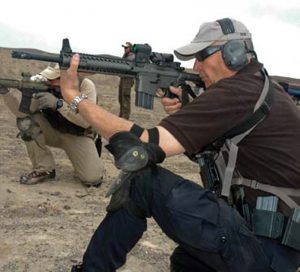
shifted to the side, allowing Aimpoint Micro T-1 to be used for closer shots.
DM CONCEPT AND TRAINING
The DM concept fills the gap between precision shooting and basic patrolrifle use. Many red-dot optics have dots that are four MOA—that means it covers four inches at 100 yards. If the gods smile, I can make good head shots with my Aimpoint Comp 4 at that range (from a bench), but I can do it better with the Leupold 1.5-5X scope I mentioned earlier.
I called Tim O’Connor at Leupold to talk about DM training. I had met Tim at Gunsite, and he’s helped me get good gear to police departments several times. Lots of coppers Tim talks to don’t want to even think about a scope over three power. Why? Granted, a fixed 6X scope will be tough to use inside a house, but a 2-6X will work just fine dialed down to 2X.
Spokane, Washington PD SWAT officer Rob Boothe tested the NGA carbine/1.5-5X scope combination in a shoot house and on the range. Rob’s opinion is that he’d just leave the scope on all the time. He had no problem getting fast, accurate hits in the shoot house with the glass at 1.5 power. Officer Boothe also carried the gun in the rack of his patrol car for three months, shooting it every week, and found no change in zero, despite bouncing around in a patrol car.
Tim was able to supply a new optic for testing. I mentioned the 1.5X5, but Tim loaned me the new HAMR optic. In the classes mentioned above, the HAMR was impressive—great clarity and magnification, but with a Delta CQ optic mounted on top.
Dan Knight, Spokane County SO, stated that it was very natural to use a cheek weld while shooting the scope, but that by raising his head slightly he could use the Delta for close-in work. I watched Dan make first-round hits on steel to 800 yards, using the ranging stadia in the HAMR. The HAMR offers an always-visible reticle and excellent performance both at distance and CQB ranges.
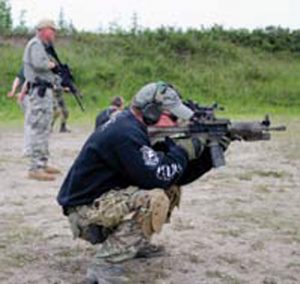
HOW SCOPES WORK
There is a misconception that a scope “gathers” light. I’ve heard this countless times over the years, mostly from guys behind the counter at the gun shop. They’re trying to sell you the benefits of a high-dollar European scope versus the domestic brand. It isn’t true. The scope magnifies the image and makes it appear closer and sharper, but it isn’t a light-gathering optic.
The scope needs three things to transmit light from the objective (front of the scope) to the eye: the right glass for the lens, good lens coating, and good arrangement of the lenses. Everything is a trade-off, though, and you’ll have to test various optics to find the balance you need. I’ve been shooting the AR system for a long time, and the “perfect” optic still eludes me.
Position shooting and support for the rifle are important to the DM. I once missed a standing elk at 252 yards. After the miss, I moved a couple of feet and shot with the rifle resting on a log. It worked much better. I’ve never shot at a human with a scope, but I think the same would hold true.
To use positions and support, use the time-honored Smith Scrambler. This simple training aid allows at least 12 different firing positions, right and left side of cover. Training scenarios should include car hoods, trees, and elevated positions—anything that simulates a field environment.
Some instructors get all hinky when you talk about supported shooting, but if it works on critters, it’ll work on bad guys. As you know, take care not to rest the barrel on the support—use the forend, preferably with a hand or pad under it.
IN TRAINING CLASS
Any rifle training starts with a confirmation of zero. Regardless of the gun/cartridge combination, zero can change. Lots of guys figure the rifle is zeroed ‘cuz it was a year ago, and then are surprised how far off they can be when they get to the range. The scope can get knocked off and the screws can come loose, all affecting the zero.
I carefully zeroed a Leupold Prismatic Tactical Sight before I went to an EAG Tactical carbine class instructed by Pat Rogers. I made a rookie mistake and didn’t Lock-Tite the screws, so it shot loose in short order. Pat was kind enough not to kick my dumb ass, but I did suffer a few “typical lieutenant” and “Army dog” cracks, all well deserved and good natured. I zeroed the rifle in Fairbanks, Alaska at 700 feet elevation and shot it two weeks later in Colorado at 5,700 feet. My point of impact was perfect for windage but four inches high in elevation, due to the less-dense air—good to know if your area has mountains.
I tried the scope alone for one day at Pat’s class. It worked very well for most of the drills but sucked when shooting on the move—it was twice as hard and half as effective. Pat and I shot side by side, and his hits with an Aimpoint were a little faster—and slower could be critical at close range.
Things that work: Leupold scope/offset T-1, the HAMR/Delta combination, and any Aimpoint with 3X magnifier.
Departments and armed citizens should consider a DM capability. Look at what your guys really do, not what is cool, and plan and train accordingly. You might be surprised how well a Designated Marksman position can work for you.
